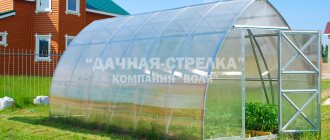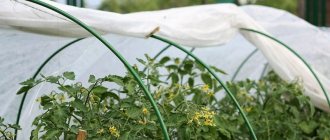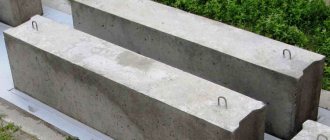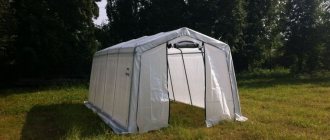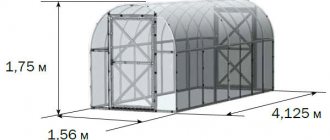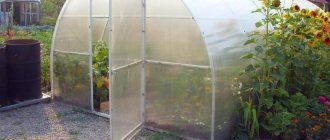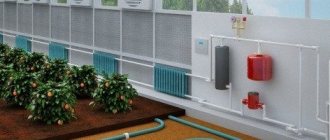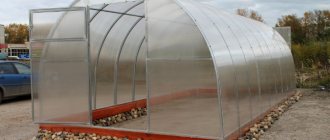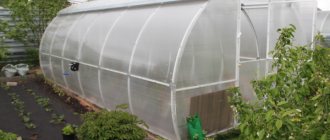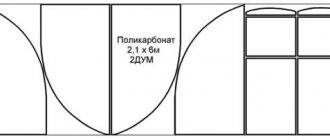Nowadays, country life is simply unthinkable without high-quality, modern greenhouses and greenhouses. The greenhouse of the “Dachnaya-Dvushka” series was developed by a domestic manufacturer three years ago. For over twenty years, we have been producing high-quality greenhouse and greenhouse structures, which are successfully used not only in summer cottages and gardens, but also in popular farm greenhouses.
Promising products have proven themselves to be high quality and effective when used in our climatic conditions. Such designs are appreciated by hundreds of thousands of Russian gardeners. Greenhouses from this manufacturer have fundamental design differences and features that make these products so popular and in demand.
Design Features
The company producing greenhouse structures and greenhouses “Volya” every year takes part in specialized displays at exhibitions. A high-quality greenhouse and greenhouse have become a symbol, and its products have been repeatedly awarded for high-quality development, modern production and a high level of technology. The design features explain the high level of performance characteristics that the greenhouse and greenhouse of the domestic manufacturer have.
The greenhouse of the “Dachnaya-Dvushka” series has small dimensions. Standard frame widths are about 2 m, which allows the use of such a modern and high-quality design for installation in small country and garden plots. Regardless of weather conditions and despite the very compact size, such a country greenhouse design is a guarantee of obtaining a bountiful harvest.
Tips for the care and operation of the “Dachnaya kopeck piece” greenhouse
In addition to the correct installation of the “Dachnaya kopeck piece” greenhouse, it is equally important to ensure good care of the shelter so that the covering material fully performs its functions: transmits light from the sun’s rays and maintains an optimal temperature.
Important! The transport film from polycarbonate sheets is removed immediately before fixing the sheet on the supports, and it must be placed upward with the side protected from sunlight.
First of all, the list of basic care rules includes:
- clearing snow from the surface during large amounts of winter precipitation, including from the side walls;
- regular autumn washing of the greenhouse, and it is better to wash off the dirt using a soap solution and clean water for rinsing (heavily contaminated areas can be wiped with a sponge or thick cloth);
- When performing cleaning activities, never use abrasive or strong agents that can damage the surface of polycarbonate and reduce its service life;
- When disinfecting a shelter, do not use sulfur bombs, as they often lead to darkening of the surface of the frame base;
- When moving the shelter to another location, always disassemble all structural elements so as not to bend them during transportation.
The “Dachnaya kopeck piece” greenhouse is a really good solution for most summer residents, both those who have been growing crops for a long time and those who have only recently taken up gardening. Proper installation and appropriate further care of the shelter will ensure complete protection of the plantings and an excellent fruit harvest.
Advantages and disadvantages
The greenhouse design of the “Dachnaya-Dvushka” model is intended to create optimal microclimatic conditions that promote the most favorable and high-quality cultivation of garden crops in dacha or garden plots. Such a greenhouse structure can have different lengths, which entirely depends on the wishes of the buyers. To obtain the required length of the greenhouse frame, it is necessary to purchase an additional type of package that has special extension inserts, which are added to the standard base length of two meters.
The indicators of the area of the covered soil completely depend on the parameters of the length of the structure. The standard height of the installed greenhouse frame is two meters and twenty centimeters. The greenhouse frame is made using galvanized iron, and high quality screws and nuts are used for assembly.
Making a foundation for a greenhouse structure is a prerequisite. However, a country greenhouse of this model can be installed on almost any type of foundation. The greenhouse can be attached to the ground by digging in special frame ends. The finished product is equipped with all the necessary elements to secure the coating. At the buyer's request, the greenhouse structure can be equipped with a special high-quality coating.
How to make a “Dachnaya kopeck piece” greenhouse from polycarbonate with your own hands at home
If you have already dealt with assembling similar structures, then no problems should arise, especially since the basic components come with clear instructions for their installation. All that is required is to choose a suitable location for installation,, if necessary, organize a foundation and install a frame in the intended location on which the polycarbonate sheets will be attached.
We recommend that you familiarize yourself with prefabricated polycarbonate greenhouses.
Selection of foundation
When choosing a place to install a greenhouse, make sure that the distance to the nearest buildings and trees is at least 2 m. It should not be too low or, conversely, too elevated, since the ideal option is a maximally flat area in the south-eastern part of the site, closed from the cold northern winds by any building.
The ends of the greenhouse shelter should face east or west, and if the garden area is located as close as possible to the road, then it is better to move it away from the fence so that dust does not eat into the polycarbonate covering. Also take into account the possibility of expanding the greenhouse in the future, so there should be at least several meters of free space along the length.
The presence of a foundation for the described structure is not a prerequisite for its installation, therefore, if soil shifts are excluded and the site is located on the most flat surface, then you can get by with just T-shaped ends on the posts, with the help of which the support is fixed in the ground. In sloping areas, especially if you plan to grow plants all year round, this solution will not work and you will have to think about a more reliable foundation.
There are several possible options in this matter:
- make a foundation from wooden blocks;
- use artificial products such as bricks and blocks for its arrangement;
- pour a shallow strip foundation.
Learn about the features of choosing a foundation for a greenhouse.
The last solution is appropriate when constructing a stationary greenhouse shelter, but before pouring concrete, it is worth once again considering all the pros and cons of such a foundation:
- it will reliably protect the root system of plants from return frosts, insect pests and heat losses;
- will prevent possible overturning and deformation of the surface of the shelter;
- will increase the height of the structure, thereby increasing the size of the usable space;
- you will no longer be able to move the greenhouse to another place;
- assembly of the structure will require much more time and the presence of an assistant;
- the costs of purchasing materials will increase, which means that the finished structure will pay for itself a little longer.
If, after comparing all the pros and cons, you still decide in favor of the popular concrete base, then you should follow these steps :
- Clear the selected area and mark it according to the parameters of the purchased greenhouse.
- Organize a trench, the depth of which will be 30 cm and the width will reach 15 cm (a horizontal level will help with this).
- Compact the bottom of the hole and pour a 10-centimeter layer of sand into it, moistening and compacting the sand cushion.
- Install formwork, for which waterproof plywood or planed boards can be used.
- Mix a solution from a mixture of sand, cement and crushed stone (2:1:2) and pour the foundation, periodically piercing the mixture with a metal rod and tapping the formwork.
Important! It will be possible to proceed to assembling the frame itself no earlier than the concrete foundation has completely dried, which may take at least 2-3 days.
Greenhouse assembly instructions
Compliance with the requirements for assembling the “Dachnaya kopeck piece” greenhouse guarantees a long service life of the product due to the strong connection of the individual component elements, so stock up on gloves and proceed to the following stages of connecting the purchased structure:
- Open the package and lay out all the contents of the delivery kit (each individual part has its own individual number, which greatly simplifies the installation process).
- Select the power arcs and first connect parts 4B and 4H to form an arc dome. In the same way, it is worth collecting all the upper parts of these elements that are in the set.
- Screw the racks to the lower parts of the connected parts. Also find foundation posts and attach them to the bottom of the regular ones.
- Attach the supporting part (usually number 3) to the foundation posts.
- Having received the required number of arches for fastening the greenhouse covering material, strengthen them with the help of horizontal ties, strut elements, radial ties and corner braces. The horizontal tie should connect two half-arcs 4H and 4B at the top.
- Install struts parallel to the “wall” arc, reinforcing them in the middle with radial ties (they connect the strut and the arc itself).
- Attach corner bars to the corner where the strut and horizontal tie are fixed to obtain fully assembled power bars.
- In the same way (with the exception of struts and ties), you need to assemble the end arcs, first by connecting the vertical elements of the future doorway and fixing them to the upper outer arcs (4VK).
- Connect the vertical and horizontal parts of the doorway with the end connecting elements.
- Fasten the foundation posts, supports and end arches, fixing them at the bottom of the latter.
- Combine the end arc with the power one, using the outer and main runs for this.
- Fasten all the power and end arcs into a single structure and connect the purlins at the required points.
- Dig a 30cm trench (if not using a foundation) and place the supplied T-ends in it, leveling the entire structure.
- Fill the hole, compact the soil and proceed to assembling the doors and windows. To do this, connect together the vertical and horizontal elements of future doors and the diagonal parts of the end windows (12DP, 14M and 13M).
- Fasten the vertical parts of the end windows 12FL and 12FP with a diagonal of 14M.
- Attach the polycarbonate to the resulting frames using clamps and washers to secure it.
- Fix the hinge seal on the door exactly in the place where the awnings will be installed.
- Secure the door seal around the perimeter of the door.
- In the same way, cover the window with covering material, fixing the diagonal (14M) over the polycarbonate covering.
- Install the hinges on the door and you can safely proceed to cutting the remaining polycarbonate material for the remaining spans of the greenhouse frame structure. Fastening of individual parts is carried out using the same fasteners as when covering vents or doors.
After lining the greenhouse with polycarbonate, all that remains is to install the end seal (where it is needed) and tape the ends of the cuts on the material used.
Video: assembly of a polycarbonate greenhouse “Dachnaya kopeck piece”
Specifications
A basic greenhouse kit requires:
- two doors;
- two windows;
- vertical amplifiers;
- horizontal amplifiers;
- T-shaped frame legs;
- longitudinal runs;
- two doorways;
- frame arches.
When ordering the basic configuration of such a greenhouse structure, the buyer receives a kit without an end seal. Such an element, important for the thermal insulation of a structure, can be ordered as an additional option.
Basic technical characteristics of the greenhouse structure:
- width is 2000 mm;
- height is 2200 mm;
- the length can be any, but the parameters are always multiples of 2000 mm;
- prefabricated greenhouse frame is made of high-quality galvanized steel profile;
- the standard distance between frame arches is 1000 mm;
- the minimum weight of the greenhouse frame is 30 kg;
- the maximum snow load is 240 kg per useful meter.
What can you grow in a greenhouse?
Greenhouses and greenhouses will help you avoid surprises and weather surprises. Of course, you can’t fit the entire garden assortment there, but the most capricious crops can be successfully grown in them. This:
- Tomatoes.
- Cucumbers.
- Peppers.
- Eggplant.
Cellophane greenhouses are a thing of the past. Now a stationary polycarbonate-covered greenhouse can be purchased freely.
Installation Features
The frame structure of the greenhouse is assembled using a set of numbered elements, some of which are prefabricated elements based on several parts. Such elements have the same number, but different indices.
The assembly of the greenhouse frame must be carried out directly on the site prepared for installation. Standard greenhouse assembly involves performing the following sequential actions:
- assembly of the first and subsequent power arcs using the parts specified in the attached instructions (to fix the elements, use 4 x 8 screws and M-4 nuts);
- if it is necessary to install the greenhouse frame on the foundation, you should compare the stages of assembling the arcs with the drawings of the instructions;
- assembly of two end frame arches;
- attaching frame purlins in accordance with the instruction drawing;
- attaching a second end frame arc;
- assembly of end parts;
- installation of doorways and hanging doors with windows.
When ordering high-quality polycarbonate sheets as a coating, you should adhere to the following criteria:
- for the smallest model of the greenhouse structure “Dachnaya-Dvushka”, it is necessary to use two sheets of polycarbonate;
- Each insert increases the consumption of covering plastic by one sheet.
Assembling the frame involves the use of the included fasteners, which secure the frame parts and covering material along the holes already provided for in the design.
You may also be interested in an article in which we talk about the rules for growing flowers in greenhouse conditions.
It should be remembered that you are responsible to the purchasers of the greenhouse structure for the availability of a complete set and installation in accordance with the attached instructions. However, the warranty does not apply to greenhouse structures installed in violation of the instructions, as well as in case of gross violations of operating rules.
Claims regarding the quality of the purchased greenhouse structure can be made by the buyer within two years from the date of purchase.
Features of the “Dachnaya kopeck piece” greenhouse
The main feature of this design lies in its narrow and elongated shape, which is explained by the relatively small width of the shelter: no more than 2 m as standard. Compact dimensions allow the greenhouse to be installed even in areas with limited space. Its height is 2.2 m, but the length depends on personal preferences and can be adjusted with additional inserts, with the basic indicators being 2 m. Of course, this is not the only advantage, and the disadvantages of the design cannot be ignored, which means you should be more careful before purchasing study all the pros and cons of a particular shelter.
Advantages
- The main strengths of “Dachnaya Kopeck piece” include:
- reinforced frame and increased strength;
- sufficient capacity (with the relatively small dimensions of the shelter, it is excellent for performing a wide variety of work inside);
- optimal height, which provides the ability to grow both low-growing and tall crops;
- rapid heating of the internal space and long-term heat retention due to the polycarbonate coating;
- possibility of increasing the length of the greenhouse;
- transportability and ease of installation of the structure;
- the possibility of installation without organizing a foundation (the galvanized profile prevents damage to the frame from moisture);
- compactness.
Did you know? The largest greenhouse in the world is considered to be a building called “Eden”, located in the city of Cornwall, in the UK. This is a whole complex of interconnected dome-shaped shelters, which in total occupy 0.654 hectares and reach a height of 35 m, with a width of 65 m and a length of 135 m.
Flaws
- Like any other structure, the “Dachna Kopeck piece” is not without certain drawbacks and, first of all, this list includes the following features of the greenhouse:
- insufficient space for growing a large number of crops, especially on an industrial scale;
- the possibility of cultivating the soil by only one person, since having two people inside will make it difficult for them to stay comfortably there;
- the presence of a large number of details, which will require a certain concentration on all actions, even with the most accurate instructions;
- the need for help from another person during assembly (it will not be possible to complete the task on your own);
- problematic use in very windy areas, especially without a solid foundation (due to the elongated shape and the presence of a relatively light polycarbonate coating, windage is possible).
If you correctly approach the issue of choosing a site for a greenhouse and its reliable fixation during assembly, then some of the disadvantages will not be so relevant, but as for the limited space for growing plants, for mass plantings it is really better to choose a more spacious greenhouse
How to install a greenhouse (video)
If you have a small summer cottage, it is not necessary to install a greenhouse on it, because there is a small but very spacious greenhouse “Dvushka”. The structure will take up very little space. However, it can accommodate an impressive number of plants. The frame is strong and reliable, does not rust or rot. The covering is polycarbonate, which allows you not to remove it for the winter and makes it possible to create an optimal microclimate indoors. The length of the greenhouse can be easily increased. No more than two people are required for installation. The price of the product is reasonable.
0 Taya 10/06/2015 21:24 One of my greenhouses is just as tall - 220 cm. My husband built it to suit his height. At first they planted various plants in it, but then they realized that it was very convenient to grow cucumbers and tall hybrid tomatoes that required staking.
Quote
0 LarisaZ 10/12/2015 1:43 pm I quote Ty:
One of my greenhouses is just as tall - 220 cm. My husband built it to suit his height. At first they planted various plants in it, but then they realized that it was very convenient to grow cucumbers and tall hybrid tomatoes that required staking.
and during what period do you use it?
It seems to me that this is still a large, high-quality greenhouse, and not a greenhouse. In my understanding, a greenhouse is a heated room and in winter something will grow in it. Quote +1 Sergey Nikolaevich Bazin 02/27/2017 12:37 Undoubtedly, “Dachnaya Kvushka” is good. But lately, until I touch them with my own hands, I am very careful about these products. A neighbor's polycarbonate began to crack and peel off after a few years. And my son-in-law, last year, had a similar greenhouse blown away by the wind. True, they bought their greenhouses from some left-wing sellers. I hope that “Dvushka” is made of much better quality and reliability.
Quote
-2 Vladimir 05/15/2017 07:42 Unfortunately, the instructions for assembling a 6-meter two-room apartment do not have a section on assembling a partition dividing the greenhouse into 2 parts.
If you can, send me my soap. Thanks in advance. Quote
Consumer Reviews
Consumer reviews of the product are mostly positive. The greenhouse is great for small summer cottages, the price is low, the quality of the materials is high. The structure makes it possible to obtain decent harvests even in a small area, despite unfavorable weather conditions.
If you have a small summer cottage, it is not necessary to install a greenhouse on it, because there is a small but very spacious greenhouse “Dvushka”
All necessary fasteners are included, which greatly simplifies assembly. No foundation is required for installation, which is also a definite plus for many consumers.
The big advantage of the greenhouse is that it is made of galvanized profile. This means that it will not be damaged by moisture, and the structure will not rust.
It’s also good that the coating is made of polycarbonate: unlike film, the material lasts a long time and there is no need to change it often. At the same time, polycarbonate sheets look much more aesthetically pleasing.
The length of the structure can be chosen, which is very convenient. The best option is a 6-meter building. It's convenient to work inside. Reviews say that the greenhouse is quite high, you can stand in it at full height.
All necessary fasteners are included, which greatly simplifies assembly. No foundation is required for installation, which is also a definite plus for many consumers.
We also invite you to familiarize yourself with other types of greenhouses from by reading the corresponding article on our resource.
How a greenhouse can attract the attention of a summer resident
The advantages of the product are as follows:
- Long service life and durability.
- Easy to assemble and maintain.
- Compactness and the ability to set up a greenhouse on a small plot of land.
- Affordable price. It consists of several components, and several factors influence it.
The kit does not include an end seal, so the buyer can find the best options himself. The width of the greenhouse itself is smaller than the usual standard one. This combines 2 positive aspects at once: compact placement and reduced price. During the off-season, you can purchase a greenhouse at a lower price, so if you set a goal in advance, you can benefit from it.
Despite the simplicity of the design and the instructions included in the kit, for inexperienced gardeners and those who have not previously encountered the assembly and installation of greenhouse structures, the task can be difficult. Before starting work, it is important to carefully study the instructions, roughly understand, and, in extreme cases, enlist support.
